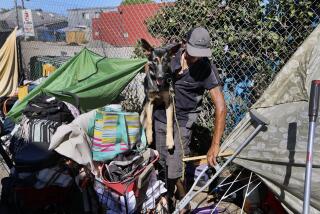Hundreds of homeless people kicked off the streets as San Diego battles hepatitis A outbreak that has killed 17
- Share via
Hundreds of homeless people have been evicted from several downtown San Diego streets that were lined with tents in recent days as the city ramps up efforts to curb a hepatitis A outbreak that has left 17 people dead.
While those people have been displaced, plans are underway to open the first city-sanctioned homeless camp in a parking lot off of 20th and B streets.
The city also began power-washing sidewalks with bleach in more neighborhoods on Wednesday as part of its multipronged effort to try to stop the hepatitis A outbreak.
As of Wednesday morning, rows of tents that had become a common sight around 16th and 17th streets near Imperial Avenue east of downtown had disappeared. It was unclear where the people who had lived in the makeshift housing had gone.
“We’re trying to find out where people went,” said Bob McElroy, president and CEO of the Alpha Project. “My teams are going to go down to the riverbed to see if they’re down there. They’re out looking for them.”
San Diego police Lt. Scott Wahl said Wednesday that authorities had cracked down on people camping in the areas as part of the city’s effort to fight a hepatitis A outbreak that has mostly affected homeless people.
The hepatitis A virus is spread through fecal matter, and steps to fight the outbreak have included installing more public restrooms and hand-washing stations downtown and power-washing sidewalks with a bleach solution.
A city-contracted crew began washing downtown sidewalks Sept. 11, and on Wednesday, workers expanded those efforts to include Pacific Beach, Ocean Beach and the Midway area. Crews will begin cleaning some areas of Mid-City and Uptown San Diego on Friday.
City workers already had been removing trash around Father Joe’s Villages, Petco Park and the San Diego Concourse each Monday.
Many of the roughly 1,000 homeless people who live downtown regularly pack up their belongs before dawn on cleanup day to make way for crews, who remove about three tons of debris from the sidewalks each week. When they returned to the sites on Monday, however, they were met by police officers, who told them not to come back.
Wahl said the area had to be cleared to break the cycle that has caused the hepatitis virus to spread.
Warth writes for the San Diego Union-Tribune.
ALSO
UC Irvine opens expansive food pantry as more college students struggle with hunger
FAA to change John Wayne Airport flight path over Newport Beach after noise complaints, city says
More to Read
Sign up for Essential California
The most important California stories and recommendations in your inbox every morning.
You may occasionally receive promotional content from the Los Angeles Times.










